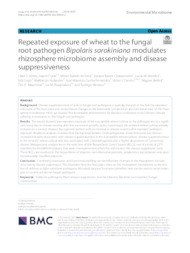Repeated exposure of wheat to the fungal root pathogen Bipolaris sorokiniana modulates rhizosphere microbiome assembly and disease suppressiveness.
Repeated exposure of wheat to the fungal root pathogen Bipolaris sorokiniana modulates rhizosphere microbiome assembly and disease suppressiveness.
Author(s): COSTA, L. S. A. S.; FARIA, M. R. de; CHIARAMONTE, J. B.; MENDES, L. W.; SEPO, E.; HOLLANDER, M. de; FERNANDES, J. M. C.; CARRIÓN, V. J.; BETTIOL, W.; MAUCHLINE, T. H.; RAAIJMAKERS, J. M.; MENDES, R.
Summary: Abstract: Background -Disease suppressiveness of soils to fungal root pathogens is typically induced in the field by repeated infections of the host plant and concomitant changes in the taxonomic composition and functional traits of the rhizosphere microbiome. Here, we studied this remarkable phenomenon for Bipolaris sorokiniana in two wheat cultivars differing in resistance to this fungal root pathogen. Results: The results showed that repeated exposure of the susceptible wheat cultivar to the pathogen led to a significant reduction in disease severity after five successive growth cycles. Surprisingly, the resistant wheat cultivar, initially included as a control, showed the opposite pattern with an increase in disease severity after repeated pathogen exposure. Amplicon analyses revealed that the bacterial families Chitinophagaceae, Anaerolineaceae and Nitrosomonadaceae were associated with disease suppressiveness in the susceptible wheat cultivar; disease suppressiveness in the resistant wheat cultivar was also associated with Chitinophagaceae and a higher abundance of Comamonadaceae. Metagenome analysis led to the selection of 604 Biosynthetic Gene Clusters (BGCs), out of a total of 2,571 identified by AntiSMASH analysis, that were overrepresented when the soil entered the disease suppressive state. These BGCs are involved in the biosynthesis of terpenes, non-ribosomal peptides, polyketides, aryl polyenes and post-translationally modified peptides. Conclusion: Combining taxonomic and functional profiling we identified key changes in the rhizosphere microbiome during disease suppression. This illustrates how the host plant relies on the rhizosphere microbiome as the first line of defense to fight soil-borne pathogens. Microbial taxa and functions identified here can be used in novel strategies to control soil-borne fungal pathogens.
Publication year: 2023
Types of publication: Journal article
Unit: Embrapa Wheat
Observation
Some of Embrapa's publications are published as ePub files. To read them, use or download one of the following free software options to your computer or mobile device. Android: Google Play Books; IOS: iBooks; Windows and Linux: Calibre.
Access other publications
Access the Agricultural Research Database (BDPA) to consult Embrapa's full library collection and records.
Visit Embrapa Bookstore to purchase books and other publications sold by Embrapa.

